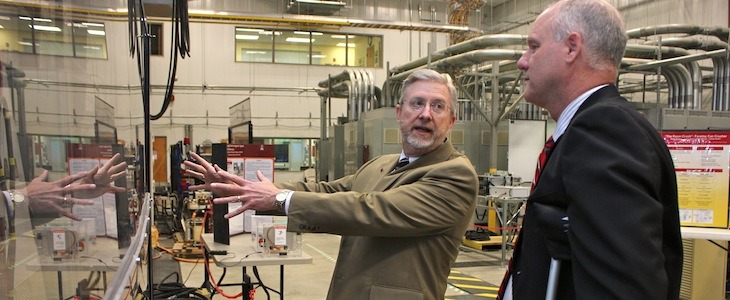UA energy research center to expand tests of power electronics, cybersecurity vulnerabilities
by May 3, 2018 5:00 pm 862 views

(from left) Dr. Alan Mantooth, executive director of the National Center for Reliable Electric Power Transmission, gives a tour of the center to Sen. Jim Hendren, R-Gravette. The center in south Fayetteville celebrated the completion of a $3.2 million expansion project.
Nearly 100 people, including business, state and university officials, celebrated the completion of a $3.2 million project to expand an electricity research center at the University of Arkansas.
On Thursday (May 3), the UA hosted a ribbon cutting and tours for the expanded 12,000-square-foot National Center for Reliable Electric Power Transmission (NCREPT) at the Arkansas Research and Technology Park in south Fayetteville.
The university paid for the 5,000-square-foot expansion that will allow the center to expand the scope of its work, including cybersecurity projects, testing power electronics and improving the electric grid. The 6-megawatt center is the highest power test facility on any U.S. university campus, and companies pay to use the center to test power electronics before using them at their business. About 50 companies have worked with the center, which was established in 2008, said executive director Dr. Alan Mantooth, who’s an electrical engineering professor for the UA.
The project to expand the center was completed in about 10 months and has allowed the center to offer direct current (DC) testing. Previously, the center offered only alternating current (AC) testing. The center also is working to improve cybersecurity, and has researchers who attempt to hack into electric power devices in order to test for vulnerabilities.
In 2015, the U.S. Department of Energy gave $12.2 million, along with $3.06 million in matching funds from the UA and other recipients, to research and develop tools to secure the U.S. electric grid from cyber threats. In late 2017, the National Center for Reliable Electric Power Transmission received the funding to begin the hacking research, Mantooth said. Arkansas Electric Cooperative Corp., a wholesale power provider for 17 electric utilities in Arkansas, is working with the center on cybersecurity testing.
Sen. Jim Hendren, R-Gravette, said he would seek legislation in January to improve the cybersecurity of infrastructure, government and election systems. Hendren, who owns plastic products manufacturer Hendren Plastics Inc., said his company and schools on the state network have been impacted by ransomware.
“We are really at a state of cyberwarfare right now in this country,” Hendren said. “Because of my military deployments, I am able to see and know what is happening everyday with our adversaries trying to penetrate our critical infrastructure. If you don’t know, you may not want to know because it’s somewhat terrifying about the capabilities that they have and the efforts that are being made to be able to wage cyber warfare against this country.”
He explained that if an adversary were to shut down the electric grid, it would impact schools, businesses and the economy.
“The work you are doing here, it may cost millions on the front end, but it will probably save hundreds of millions on the back end if Arkansas is one of the places that the lights are still on when the attacks do come.”
The center has two staff, and it soon might hire another, Mantooth said. Between 14 and 15 university students also work at the center. Faculty involved with the center have grown from four to more than 13, making them the largest power group in America. The amount the group spends on research is about $20,000 daily, or $7.3 million annually, and is supported by industry and state and federal governments.
“The support that the state of Arkansas provides to the small businesses that are coming out of this is the backend of all of this work in a lot of cases,” Mantooth said. “As a result of that, their R&D tax credits and the other things they do to support those small businesses is really big. Whether those flow through the Economic Development Commission or other areas of the state agencies, all of that support is key to making sure that what we do doesn’t wither on the vine as it were, and then goes out and it bears fruit. That’s very important.”
The center has received more than $100 million in external funding since it was established to modernize the electric power grid, said Jim Coleman, provost and executive vice chancellor for academic affairs at the UA.
“As I’ve told people all over the world,” Mantooth said, “if I could put 50 kilowatts of processing power in the palm of your hand, what are the things that you can design and build now, how far will that car go, how far will that plane fly and how green will it be in its journey to get there? These are the things that we’re working on, and believe me, when you start looking at the age of drones and other things, we may have personal aircraft. What does the future hold? We’ll be a part of that because our job here is to make it smaller, lighter and more powerful.”
UA Chancellor Joseph Steinmetz joked he’s wanted a jet pack since he was eight years old, and he might get his wish through the work the center is doing to create miniature power sources.
